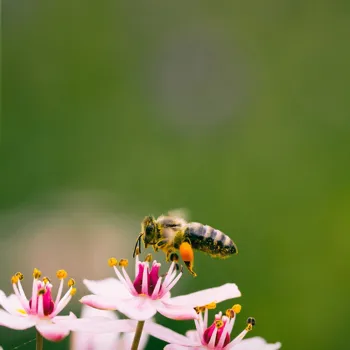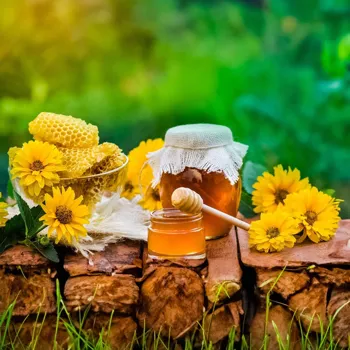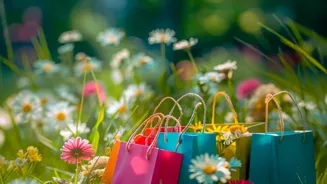Discover how to create a haven for bees in your garden! Learn 8 ways to attract pollinators and save the bees
Our buzzy buddies, the bees, are facing a tough time. Their numbers are declining, and that's
bad news for all of us. Bees are vital pollinators, meaning they help plants reproduce. Without them, we wouldn't have many of the fruits, vegetables, and flowers we enjoy.
Fortunately, we can all do our bit to help. Turning your garden into a pollinator paradise is easier than you think! Here are eight simple ways to attract bees and other beneficial insects and support their survival:
Plant a Variety of Native Flowers:
Think of your garden as a bee buffet! A diverse selection of native flowers is the key to attracting a wide range of pollinators. Avoid hybrid flowers that often lack pollen and nectar.
Native plants are perfectly adapted to your local climate and provide the best nourishment for local bee populations. Do a little research to find out which flowers are native to your area. Some popular choices include sunflowers, lavender, marigolds, zinnias, and cosmos.
Plant them in clumps for a more visually appealing display and to make it easier for bees to find them. Remember to choose flowers that bloom at different times of the year to provide a continuous source of food throughout the growing season.
This will also help attract honey bees as it helps the honey they procure to be sweeter and healthier.
Native flowers are naturally suited to the soil conditions and climate of your area, so they require less care and attention compared to exotic varieties.
This means you'll spend less time watering, fertilizing, and fighting off pests and diseases. Furthermore, native plants often attract other beneficial insects, such as ladybugs and hoverflies, which can help control garden pests naturally.
By choosing native flowers, you're not only supporting pollinators but also creating a more sustainable and resilient garden ecosystem. This will ultimately benefit the overall health and beauty of your garden.
Think of planting a variety of flowers, ranging from yellow flowers to purple flowers to even blue ones. The colour palette will attract any pollinator in a heartbeat, especially the butterflies. The key is to create a vibrant garden.
By planting a diverse and colourful array of native flowers, you're essentially creating a welcoming haven for pollinators in your backyard. You're providing them with a reliable source of food and shelter, helping them thrive and contribute to the health of your local ecosystem.
It's a win-win situation for both you and the bees! So, get your hands dirty, explore the wonderful world of native flowers, and transform your garden into a vibrant pollinator paradise.
Remember, every little bit counts, and even a small patch of native flowers can make a big difference in supporting our precious pollinators.
Native flowers, with their unique shapes and colours, are like a beacon, signalling to pollinators that your garden is a safe and reliable source of sustenance.
By choosing native wildflowers, you're not only supporting our buzzy fellows but also contributing to biodiversity and preserving the natural heritage of your region.
Provide Fresh Water:
Just like us, bees get thirsty! Provide a shallow dish or birdbath filled with water and pebbles or marbles for them to land on. This will prevent them from drowning while they drink. Change the water regularly to keep it clean and free of algae.
A simple saucer filled with water and a few stones will do the trick. Place it in a shady spot in your garden, away from direct sunlight that could cause the water to evaporate quickly.
You can also add a few drops of honey to the water to attract bees, but be careful not to add too much, as it could attract unwanted pests. Remember, providing a reliable source of fresh water is crucial for bees, especially during hot and dry weather.
A small water source can make a big difference in attracting pollinators to your garden. Bees need water not only to quench their thirst but also to cool down their hives and dilute honey. They also use water to carry out daily tasks, such as pollen collection.
Offering a dedicated water source for bees ensures that they have access to this essential resource without having to travel far and wide. By providing a safe and accessible drinking spot, you're making your garden even more inviting for these crucial pollinators.
This will help them thrive in your garden. You can even get a bird bath. The more the merrier.
Consider adding a water feature, such as a small fountain or a trickle of water running over rocks, to create a more natural and appealing water source for bees.
The sound of running water can also be very attractive to pollinators, drawing them in from further away. Furthermore, a water feature can add visual interest and tranquility to your garden, making it a more enjoyable space for you as well.
Remember to choose a water feature that is easy to clean and maintain, and be sure to provide plenty of shallow landing spots for bees to access the water safely. A water fountain can be a great addition.
Avoid Pesticides:
Pesticides are harmful to bees, even organic ones. Avoid using them in your garden. If you must use them, apply them in the evening when bees are less active. Opt for natural pest control methods instead, such as attracting beneficial insects or using companion planting.
Encourage natural predators of garden pests, like ladybugs, to take care of any unwanted visitors. Inspect your plants regularly for signs of infestation and address any issues promptly before they become widespread.
This will help ensure that your garden remains a safe haven for bees and other beneficial insects. Remember, a healthy and balanced garden is less susceptible to pest problems.
Pesticides can have devastating effects on bee populations, not only killing them directly but also disrupting their navigation and foraging behavior. Even small amounts of pesticide residue can weaken bees and make them more vulnerable to diseases and parasites.
By avoiding pesticides altogether, you're creating a safe and healthy environment for bees to thrive. You can use many different non-toxic options that are considered safe for the pollinators. Neem oil can be a good option.
Explore the world of natural pest control methods to keep your garden healthy and productive without harming bees. Companion planting, for example, involves growing certain plants together that benefit each other. Some plants can repel pests, while others attract beneficial insects.
You can also use natural remedies, such as insecticidal soap or garlic spray, to control pests without harming bees. With a little bit of knowledge and effort, you can create a pest-free garden that is safe and inviting for pollinators.
Provide Shelter:
Bees need shelter from the elements and a place to nest. Leave some areas of your garden undisturbed, with a layer of leaf litter or dead wood. You can also build or buy a bee hotel, a structure with small holes and tubes that provide nesting sites for solitary bees.
Bee hotels can be a fun and educational project for the whole family. Place them in a sunny spot in your garden, preferably facing south or east. Make sure the bee hotel is securely mounted to prevent it from falling or being damaged by wind or rain.
Clean the bee hotel regularly to prevent the build-up of parasites or diseases. Remember, providing shelter is essential for bees to thrive in your garden.
Bees are social animals and need a place to rest and lay their eggs.
By providing shelter, you're creating a welcoming environment for bees to build their nests and raise their young. This will help increase the local bee population and ensure that your garden is buzzing with activity.
A bee hotel can also add visual interest to your garden, becoming a focal point that attracts attention and sparks conversation. So, get creative and build or buy a bee hotel to provide shelter for these essential pollinators.
Consider providing a variety of shelter options to attract different types of bees. Some bees prefer to nest in underground burrows, while others prefer to nest in hollow stems or crevices in wood.
By offering a range of nesting sites, you'll be more likely to attract a diverse population of bees to your garden. You can also create a natural shelter by leaving some areas of your garden undisturbed, with a layer of leaf litter or dead wood.
This will provide a habitat for a variety of insects, including bees, and create a more natural and balanced ecosystem in your garden.
Plant in Sunny Spots:
Most flowering plants need sunlight to thrive, and so do bees! Plant your pollinator-friendly flowers in sunny spots in your garden to ensure they get the energy they need to produce nectar and pollen. Make sure the area gets direct sunlight during the majority of the day.
If the area is partially shaded, make sure that the plants still get at least four hours of sunlight a day. You can always get a light meter to check what works well for you.
Plants that are planted in sunny spots are better able to produce nectar and pollen, which are essential food sources for bees and other pollinators. The sunlight also helps the plants to grow stronger and healthier, making them more resistant to pests and diseases.
By planting in sunny spots, you're ensuring that your plants are thriving and providing the best possible nourishment for pollinators. This helps them to thrive in your garden.
Observe your garden throughout the day to identify the sunniest areas.
Take note of how the sunlight changes throughout the seasons and plan your planting accordingly. You may need to adjust your planting scheme to ensure that your plants are getting enough sunlight throughout the year.
Remember, providing the right growing conditions is crucial for the success of your pollinator garden. Ensure to plant your garden where plants can flourish.
Let Your Herbs Flower:
Don't be too quick to trim your herbs! Allowing your herbs to flower will provide a valuable source of nectar and pollen. Bees love the flowers of herbs like basil, mint, rosemary, and lavender. Once you stop them from flowering, they can't flourish in your garden.
Be sure to keep pruning the plants, to allow new growth to happen.
Herb flowers are a valuable resource for pollinators, providing them with a steady source of food throughout the growing season. The flowers are often rich in nectar and pollen, which are essential for bees to survive and reproduce.
By letting your herbs flower, you're providing a valuable service to pollinators and helping to support their populations. It is especially important for lavender as that is like bee crack!
Don't be afraid to experiment with different types of herbs in your pollinator garden.
There are many different varieties of herbs that produce beautiful and fragrant flowers that are attractive to bees. Some popular choices include basil, mint, rosemary, lavender, thyme, and oregano.
By planting a variety of herbs, you'll be providing a diverse source of food for pollinators and creating a more interesting and visually appealing garden.
Avoid Herbicides:
Herbicides can kill the wildflowers and weeds that bees rely on for food. Avoid using them in your garden. If you must use them, apply them carefully and avoid spraying them near flowering plants. There are many natural ways to control weeds, such as mulching, hand-pulling, and using a hoe.

Keep them clear and prevent them from growing out of control.
Herbicides can have devastating effects on bee populations, not only killing the plants that bees rely on for food but also disrupting their navigation and foraging behavior.
Even small amounts of herbicide residue can weaken bees and make them more vulnerable to diseases and parasites. By avoiding herbicides altogether, you're creating a safe and healthy environment for bees to thrive.
Explore the world of natural weed control methods to keep your garden healthy and productive without harming bees. Mulching, for example, can suppress weed growth by blocking sunlight and preventing seeds from germinating.
Hand-pulling weeds is another effective method, especially for small infestations. You can also use a hoe to cultivate the soil and remove weeds before they become established. With a little bit of effort, you can create a weed-free garden that is safe and inviting for pollinators.
Support Local Beekeepers:
Buy local honey and beeswax products to support local beekeepers. Beekeepers play a vital role in maintaining bee populations and educating the public about the importance of bees. By supporting them, you're helping to ensure the survival of these essential pollinators.

It is a mutual agreement and you are supporting them.
Local honey is not only delicious but also contains pollen that is specific to your region. This can help to desensitize you to local allergens and reduce your allergy symptoms.
Beeswax products, such as candles and lip balms, are also a great way to support local beekeepers. These products are natural, sustainable, and often have beneficial properties.
Visit your local farmer's market or search online to find local beekeepers in your area.
Talk to them about their beekeeping practices and learn more about the importance of bees. By supporting local beekeepers, you're investing in the health of your local ecosystem and helping to ensure the survival of these essential pollinators.
You can even help start an organization to spread awareness.
AI Generated Content. Glance/InMobi shall have no liability for the content